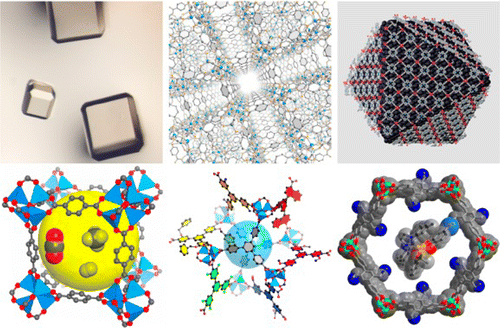当前位置:
X-MOL 学术
›
J. Am. Chem. Soc.
›
论文详情
Our official English website, www.x-mol.net, welcomes your
feedback! (Note: you will need to create a separate account there.)
Covalent Chemistry beyond Molecules
Journal of the American Chemical Society ( IF 14.4 ) Pub Date : 2016-02-23 , DOI: 10.1021/jacs.5b10666 Juncong Jiang 1 , Yingbo Zhao 1 , Omar M. Yaghi 1, 2
Journal of the American Chemical Society ( IF 14.4 ) Pub Date : 2016-02-23 , DOI: 10.1021/jacs.5b10666 Juncong Jiang 1 , Yingbo Zhao 1 , Omar M. Yaghi 1, 2
Affiliation

|
Linking molecular building units by covalent bonds to make crystalline extended structures has given rise to metal-organic frameworks (MOFs) and covalent organic frameworks (COFs), thus bringing the precision and versatility of covalent chemistry beyond discrete molecules to extended structures. The key advance in this regard has been the development of strategies to overcome the "crystallization problem", which is usually encountered when attempting to link molecular building units into covalent solids. Currently, numerous MOFs and COFs are made as crystalline materials in which the large size of the constituent units provides for open frameworks. The molecular units thus reticulated become part of a new environment where they have (a) lower degrees of freedom because they are fixed into position within the framework; (b) well-defined spatial arrangements where their properties are influenced by the intricacies of the pores; and (c) ordered patterns onto which functional groups can be covalently attached to produce chemical complexity. The notion of covalent chemistry beyond molecules is further strengthened by the fact that covalent reactions can be carried out on such frameworks, with full retention of their crystallinity and porosity. MOFs are exemplars of how this chemistry has led to porosity with designed metrics and functionality, chemically-rich sequences of information within their frameworks, and well-defined mesoscopic constructs in which nanoMOFs enclose inorganic nanocrystals and give them new levels of spatial definition, stability, and functionality.
中文翻译:

超越分子的共价化学
通过共价键连接分子构建单元以形成晶体扩展结构已经产生了金属有机框架 (MOF) 和共价有机框架 (COF),从而使共价化学的精确性和多功能性从离散分子扩展到扩展结构。在这方面的关键进步是开发了克服“结晶问题”的策略,当试图将分子构建单元连接到共价固体时通常会遇到这种问题。目前,许多 MOF 和 COF 被制成晶体材料,其中大尺寸的组成单元提供了开放的框架。如此网状化的分子单元成为新环境的一部分,在那里它们具有 (a) 较低的自由度,因为它们固定在框架内的位置上;(b) 明确定义的空间排列,其特性受孔隙复杂性的影响;(c) 有序模式,官能团可以共价连接到其上以产生化学复杂性。共价反应可以在这样的框架上进行,并完全保留它们的结晶度和孔隙率,这一事实进一步加强了分子之外的共价化学的概念。MOF 是这种化学如何通过设计的指标和功能导致孔隙率、其框架内富含化学物质的信息序列以及明确定义的介观结构的示例,其中纳米 MOF 包围无机纳米晶体并赋予它们新的空间定义、稳定性、和功能。(c) 有序模式,官能团可以共价连接到其上以产生化学复杂性。共价反应可以在这样的框架上进行,并完全保留它们的结晶度和孔隙率,这一事实进一步加强了分子之外的共价化学的概念。MOF 是这种化学如何通过设计的度量和功能导致孔隙率、其框架内富含化学物质的信息序列以及明确定义的介观结构的示例,其中纳米 MOF 包围无机纳米晶体并赋予它们新的空间定义、稳定性、和功能。(c) 有序模式,官能团可以共价连接到其上以产生化学复杂性。共价反应可以在这样的框架上进行,并完全保留它们的结晶度和孔隙率,这一事实进一步加强了分子之外的共价化学的概念。MOF 是这种化学如何通过设计的度量和功能导致孔隙率、其框架内富含化学物质的信息序列以及明确定义的介观结构的示例,其中纳米 MOF 包围无机纳米晶体并赋予它们新的空间定义、稳定性、和功能。共价反应可以在这样的框架上进行,并完全保留它们的结晶度和孔隙率,这一事实进一步加强了分子之外的共价化学的概念。MOF 是这种化学如何通过设计的度量和功能导致孔隙率、其框架内富含化学物质的信息序列以及明确定义的介观结构的示例,其中纳米 MOF 包围无机纳米晶体并赋予它们新的空间定义、稳定性、和功能。共价反应可以在这样的框架上进行,并完全保留它们的结晶度和孔隙率,这一事实进一步加强了分子之外的共价化学的概念。MOF 是这种化学如何通过设计的度量和功能导致孔隙率、其框架内富含化学物质的信息序列以及明确定义的介观结构的示例,其中纳米 MOF 包围无机纳米晶体并赋予它们新的空间定义、稳定性、和功能。
更新日期:2016-02-23
中文翻译:

超越分子的共价化学
通过共价键连接分子构建单元以形成晶体扩展结构已经产生了金属有机框架 (MOF) 和共价有机框架 (COF),从而使共价化学的精确性和多功能性从离散分子扩展到扩展结构。在这方面的关键进步是开发了克服“结晶问题”的策略,当试图将分子构建单元连接到共价固体时通常会遇到这种问题。目前,许多 MOF 和 COF 被制成晶体材料,其中大尺寸的组成单元提供了开放的框架。如此网状化的分子单元成为新环境的一部分,在那里它们具有 (a) 较低的自由度,因为它们固定在框架内的位置上;(b) 明确定义的空间排列,其特性受孔隙复杂性的影响;(c) 有序模式,官能团可以共价连接到其上以产生化学复杂性。共价反应可以在这样的框架上进行,并完全保留它们的结晶度和孔隙率,这一事实进一步加强了分子之外的共价化学的概念。MOF 是这种化学如何通过设计的指标和功能导致孔隙率、其框架内富含化学物质的信息序列以及明确定义的介观结构的示例,其中纳米 MOF 包围无机纳米晶体并赋予它们新的空间定义、稳定性、和功能。(c) 有序模式,官能团可以共价连接到其上以产生化学复杂性。共价反应可以在这样的框架上进行,并完全保留它们的结晶度和孔隙率,这一事实进一步加强了分子之外的共价化学的概念。MOF 是这种化学如何通过设计的度量和功能导致孔隙率、其框架内富含化学物质的信息序列以及明确定义的介观结构的示例,其中纳米 MOF 包围无机纳米晶体并赋予它们新的空间定义、稳定性、和功能。(c) 有序模式,官能团可以共价连接到其上以产生化学复杂性。共价反应可以在这样的框架上进行,并完全保留它们的结晶度和孔隙率,这一事实进一步加强了分子之外的共价化学的概念。MOF 是这种化学如何通过设计的度量和功能导致孔隙率、其框架内富含化学物质的信息序列以及明确定义的介观结构的示例,其中纳米 MOF 包围无机纳米晶体并赋予它们新的空间定义、稳定性、和功能。共价反应可以在这样的框架上进行,并完全保留它们的结晶度和孔隙率,这一事实进一步加强了分子之外的共价化学的概念。MOF 是这种化学如何通过设计的度量和功能导致孔隙率、其框架内富含化学物质的信息序列以及明确定义的介观结构的示例,其中纳米 MOF 包围无机纳米晶体并赋予它们新的空间定义、稳定性、和功能。共价反应可以在这样的框架上进行,并完全保留它们的结晶度和孔隙率,这一事实进一步加强了分子之外的共价化学的概念。MOF 是这种化学如何通过设计的度量和功能导致孔隙率、其框架内富含化学物质的信息序列以及明确定义的介观结构的示例,其中纳米 MOF 包围无机纳米晶体并赋予它们新的空间定义、稳定性、和功能。




















































 京公网安备 11010802027423号
京公网安备 11010802027423号